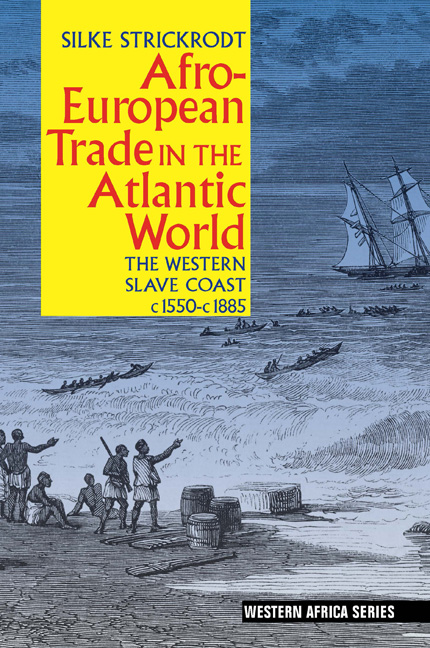Book contents
- Frontmatter
- Dedication
- Contents
- List of Maps
- List of Abbreviations
- Acknowledgements
- Map
- Introduction
- 1 The regional setting
- 2 The Atlantic connection: Little Popo & the rise of Afro-European trade, c.1600 to 1702
- 3 The era of the warrior kings: 1702 to 1772
- 4 The era of the traders: 1772 to c.1807
- 5 Disintegration & reconstitution: Political developments, 1820s to 1870s
- 6 From slaves to palm oil: Afro-European trade, c.1807 to 1870s
- Epilogue: The colonial partition & its consequences, 1870s to c.1900
- Bibliography
- Index
6 - From slaves to palm oil: Afro-European trade, c.1807 to 1870s
Published online by Cambridge University Press: 05 May 2015
- Frontmatter
- Dedication
- Contents
- List of Maps
- List of Abbreviations
- Acknowledgements
- Map
- Introduction
- 1 The regional setting
- 2 The Atlantic connection: Little Popo & the rise of Afro-European trade, c.1600 to 1702
- 3 The era of the warrior kings: 1702 to 1772
- 4 The era of the traders: 1772 to c.1807
- 5 Disintegration & reconstitution: Political developments, 1820s to 1870s
- 6 From slaves to palm oil: Afro-European trade, c.1807 to 1870s
- Epilogue: The colonial partition & its consequences, 1870s to c.1900
- Bibliography
- Index
Summary
In 1807 Great Britain abolished its slave trade, making it illegal for British subjects to engage in the slave trade from 1 May 1807. From then on, there followed a number of acts and treaties with other countries which progressively restricted the slave trade. At the Congress of Vienna in 1815, the European nations stated their desire for the universal abolition of the trade while reserving their right to do so in their own time. In the same year, Portugal agreed to abolish the slave trade north of the equator. In order to enforce the abolition of the trade, British men of war patrolled the West African coast, among others, capturing suspicious vessels. From the 1840s they were joined, theoretically at least, by French, American and Portuguese cruisers. Captured vessels were sent for adjudication to the court of mixed commission at Sierra Leone and, after 1842, also to other places such as Luanda.
Initially, however, these developments did not have great consequences for trade on the western Slave Coast, which continued to export slaves as well as ivory and provisions. If anything, the region's trade was boosted because, in order to avoid the surveillance of the British cruisers, slaves were sent from the established ports on the Gold Coast to the western Slave Coast to be shipped from there. This was noted by a British trader in 1830: ‘At Accra there is a great deal [of slaving]; the slaves are sent down, perhaps as far as [Little] Popoe, by small canoes…’ Another trader, who had been active on the coast between 1818 and the late 1830s, reported that ‘There has been no slaving on the Gold Coast till you come down to [Little] Popo and Whydah’, although in the late 1830s ‘there was very little [slave trade]’. According to him, Little Popo's main trade was in ivory and dollars.
- Type
- Chapter
- Information
- Afro-European Trade in the Atlantic WorldThe Western Slave Coast, c. 1550–c.1885, pp. 195 - 224Publisher: Boydell & BrewerPrint publication year: 2015



